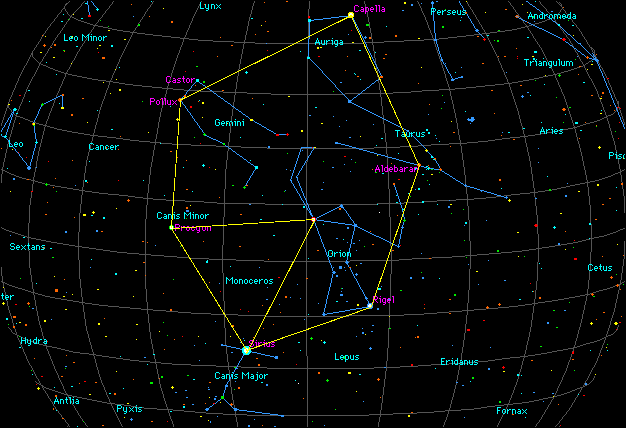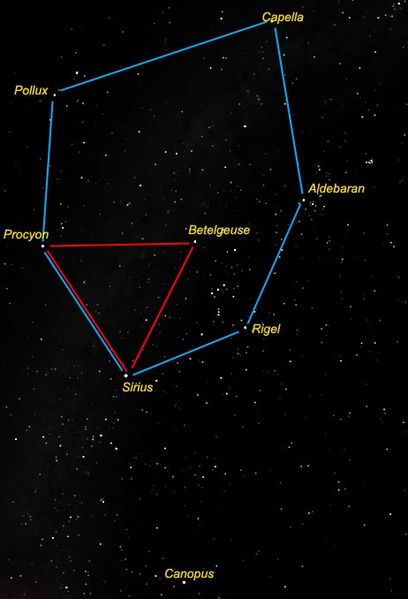
On March 3 and 4, 2020, the waxing moon is moving inside the Winter Circle, sometimes called the Winter Hexagon. It’s a large circular (hexagonal) star asterism – not one of the 88 official constellations, but just a noticeable pattern of stars – consisting of seven bright stars in six separate constellations:
Capella – brightest star in the constellation Auriga the Charioteer
Pollux – brightest star in the constellation Gemini the Twins
Castor – second-brightest star in the constellation Gemini the Twins
Procyon – brightest star in the the constellation Canis Minor the Lesser Dog
Sirius – brightest star in the constellation Canis Major the Greater Dog
Rigel – brightest star in the constellation Orion the Hunter
Aldebaran – brightest star in the constellation Taurus the Bull
With the exception of the star Caster in Gemini, the Winter Circle stars are what we call 1st-magnitude. That is, they’re the brightest stars in our sky. Technically speaking, Castor is slightly fainter at 2nd-magnitude, though it’s the brightest of all the 2nd-magnitude stars in the sky.
Near the center of the Circle, you’ll find center Orion’s bright red star Betelgeuse, which, in late 2019, began an unexpected dimming, causing some to suggest that it might be about to go supernova. We hear from many observers now, though, that Betelgeuse is returning to its usual brightness. On February 22, 2020, via The Astronomer’s Telegram, astronomers reported:
Betelgeuse has definitely stopped dimming and has started to slowly brighten.

The Winter Circle (or Hexagon) contains another pattern known as the Winter Triangle. Image via SouledOut.org.
In the evenings in March, we in the Northern Hemisphere see the Winter Circle fill up much of our southern sky at nightfall. Elsewhere in the world – even in places where it’s not winter – the moon will also be in the midst of these Winter Circle stars.
As seen from temperate latitudes in the Southern Hemisphere, where it’s now summer, this lasso of stars appears upside-down relative to our northern view. That is, southern sky watchers will see the star Sirius at top and the star Capella at bottom.
No chart can adequately convey the Winter Circle’s humongous size! It dwarfs the constellation Orion the Hunter, which is a rather large constellation occupying the southwestern part of the Winter Circle pattern.
By the way, the moon is now showing you where the sun resides (more or less) in front of the backdrop stars in the month of June. So enjoy the Winter Circle. And contemplate the sun being in this part of the sky when summer returns to the Northern Hemisphere!

The Winter Circle, or Hexagon, is marked in blue. The Winter Triangle is marked in red. Image via Wikimedia Commons.
Bottom line: On March 3 and 4, 2020, the moon resides inside the Winter Circle, a large asterism made of seven brilliant stars.
Here are constellation charts via the International Astronomical Union (IAU)
Read more: Winter Circle, or Hexagon, made of bright stars
EarthSky astronomy kits are perfect for beginners. Order today from the EarthSky store
Donate: Your support means the world to us
from EarthSky https://ift.tt/2Hrrdca

On March 3 and 4, 2020, the waxing moon is moving inside the Winter Circle, sometimes called the Winter Hexagon. It’s a large circular (hexagonal) star asterism – not one of the 88 official constellations, but just a noticeable pattern of stars – consisting of seven bright stars in six separate constellations:
Capella – brightest star in the constellation Auriga the Charioteer
Pollux – brightest star in the constellation Gemini the Twins
Castor – second-brightest star in the constellation Gemini the Twins
Procyon – brightest star in the the constellation Canis Minor the Lesser Dog
Sirius – brightest star in the constellation Canis Major the Greater Dog
Rigel – brightest star in the constellation Orion the Hunter
Aldebaran – brightest star in the constellation Taurus the Bull
With the exception of the star Caster in Gemini, the Winter Circle stars are what we call 1st-magnitude. That is, they’re the brightest stars in our sky. Technically speaking, Castor is slightly fainter at 2nd-magnitude, though it’s the brightest of all the 2nd-magnitude stars in the sky.
Near the center of the Circle, you’ll find center Orion’s bright red star Betelgeuse, which, in late 2019, began an unexpected dimming, causing some to suggest that it might be about to go supernova. We hear from many observers now, though, that Betelgeuse is returning to its usual brightness. On February 22, 2020, via The Astronomer’s Telegram, astronomers reported:
Betelgeuse has definitely stopped dimming and has started to slowly brighten.

The Winter Circle (or Hexagon) contains another pattern known as the Winter Triangle. Image via SouledOut.org.
In the evenings in March, we in the Northern Hemisphere see the Winter Circle fill up much of our southern sky at nightfall. Elsewhere in the world – even in places where it’s not winter – the moon will also be in the midst of these Winter Circle stars.
As seen from temperate latitudes in the Southern Hemisphere, where it’s now summer, this lasso of stars appears upside-down relative to our northern view. That is, southern sky watchers will see the star Sirius at top and the star Capella at bottom.
No chart can adequately convey the Winter Circle’s humongous size! It dwarfs the constellation Orion the Hunter, which is a rather large constellation occupying the southwestern part of the Winter Circle pattern.
By the way, the moon is now showing you where the sun resides (more or less) in front of the backdrop stars in the month of June. So enjoy the Winter Circle. And contemplate the sun being in this part of the sky when summer returns to the Northern Hemisphere!

The Winter Circle, or Hexagon, is marked in blue. The Winter Triangle is marked in red. Image via Wikimedia Commons.
Bottom line: On March 3 and 4, 2020, the moon resides inside the Winter Circle, a large asterism made of seven brilliant stars.
Here are constellation charts via the International Astronomical Union (IAU)
Read more: Winter Circle, or Hexagon, made of bright stars
EarthSky astronomy kits are perfect for beginners. Order today from the EarthSky store
Donate: Your support means the world to us
from EarthSky https://ift.tt/2Hrrdca

Aucun commentaire:
Enregistrer un commentaire